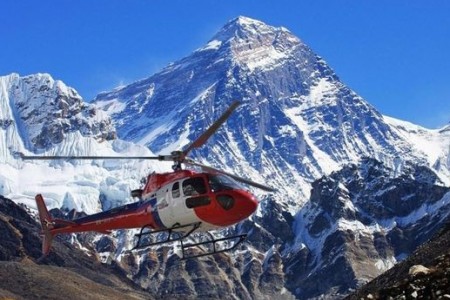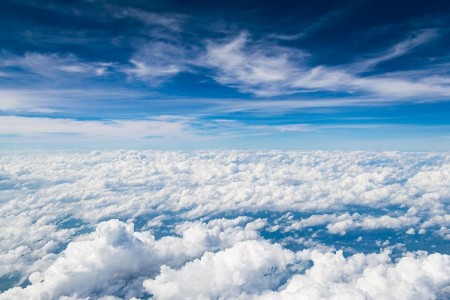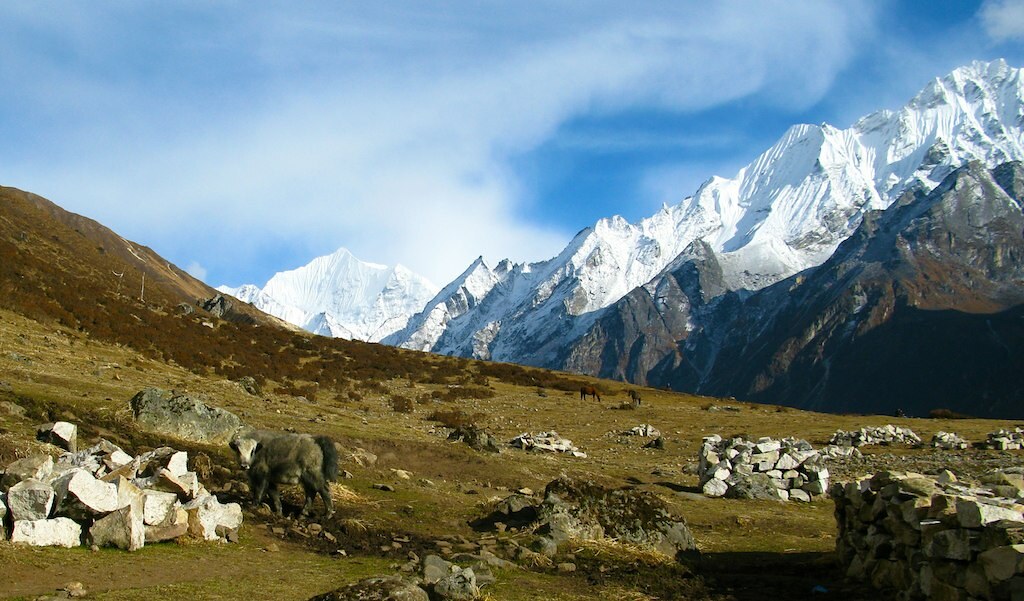 Major Highlights of Langtang Valley Trek 11 Days
Major Highlights of Langtang Valley Trek 11 Days
- Visit UNESCO Heritage Sites
- Enter one of the famous National parks
- Reach Tserko Ri the highest point of this trek
- Explore the Kyangjin Gomba
- Walkthrough forests of rhododendron
- Local culture and lifestyle of Himalayan people
- Experience warm welcome and Hospitality
- View various mountains along the way such as Ganesh Himal, Langtang Lirung, Ganchhenpo, etc
Best Time for Langtang Valley Trek 11 Days
You must be wondering what is the best time to visit Langtang Valley? Well, we can say that every season has its own benefits and disadvantages. However, most trekkers prefer to trek during the Autumn and spring season.
Autumn usually starts from the month of September and lasts until December. It is the peak season for trekkers to visit this region.
The weather is neither too hot nor too cold making it just perfect. The skies are clear making the views spectacular all the way. You will make your way through forests colored in different shades of Autumn.
The temperature can rise to 10-15 degrees during the day. The weather is warm making the trek easier. But the temperature can drop in the early mornings and night making it a little cold.
The days between January and February are usually very cold which makes walking a bit hard. Winter is the time of snow and comes under these months.
The daytime can be warm but during the night, the temperature drops below zero. It reaches up to a temperature of -3 degrees.
However, the valley looks just awesome with houses covered in the snow. Not only the valley, but the whole region looks mesmerizing submerged in white. Plus, the snowy peaks are pretty visible adding joy in your trek.
But due to cold, it gets quite challenging to reach higher points.
As the season of snow ends, Spring season arrives bringing new beginnings along with it. The months between March to May come under this season.
It is considered the second-best season after Autumn. The weather is very hot during the day making it long. The temperature rises to 10-20 degrees this time of year.
As you walk in these trails, you get to enjoy flowers blooming around the region and see wildlife at its best.
The views of the mountains are striking without any cloud blinding the peaks. It is an ecstatic period around the region.
Monsoon and Summer seasons are usually an off season for this region. In the context of Nepal, both seasons are considered the same.
During this season, there are few no. of trekkers trekking in the routes. For travelers who love to walk in silence, this is a perfect time.
The month of may is extremely hot and dry as the temperature rises above 30 degrees. While the months of June to August are hot and humid having temperatures between 10-20 degrees.
During this season, the paths are slippery and muddy due to heavy rainfall. But it also has pros such as you get to witness the local farming lifestyle of the people.
Traditional farming that can be seen from the trails is a unique experience along with the warm hospitality offered by the people.
Walking these trails will be a challenge for you. If you like challenges with exciting adventure then this season is favorable for you.
Few Trips you may like:
Tips for this trek
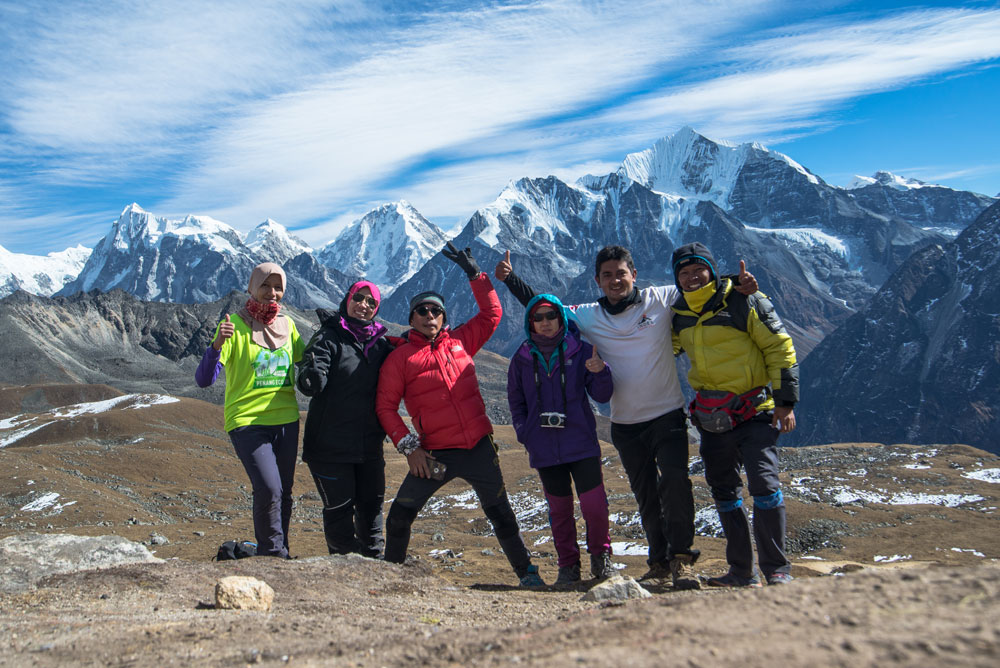 Before going on the 11 days Langtang Valley Trek you should know a few things in advance. Here are some tips for this trek:
Before going on the 11 days Langtang Valley Trek you should know a few things in advance. Here are some tips for this trek:
Train your Body
Before starting your trip, you should prepare your body two weeks before the actual trek. If you don’t then you might get tired easily and your body might start cramping up.
So you have to do physical exercises such as swimming, cycling, walking, etc. These exercises help in increasing your body stamina and keeps the trek stress away.
Comfortable shoes
While buying your trekking gear always make sure to check they are not damaged. In trek, shoes are important assets as you will be wearing them for many days.
If you are buying new shoes wear them for a few days. To check whether they are comfortable or not.
However, if you are planning to wear your old shoes. Then check them thoroughly whether they can handle being worn for many days or not.
Proper Clothing
The weather is always unpredictable at higher altitudes so don’t forget to pack extra warm clothes.
While buying clothes it’s better to buy waterproof and windproof clothing. Also, don’t forget sleeping bags if you can carry them
Food and water intake
As you walk higher in the elevation, it tends to get colder which is one of the factors that drains your energy faster. To make up for the lost energy you should eat a lot of nutrients rich food and water.
You should also carry a decent amount of water and foods containing protein and carbohydrates. If you eat right and keep yourself hydrated there are fewer chances of you getting Altitude sickness.
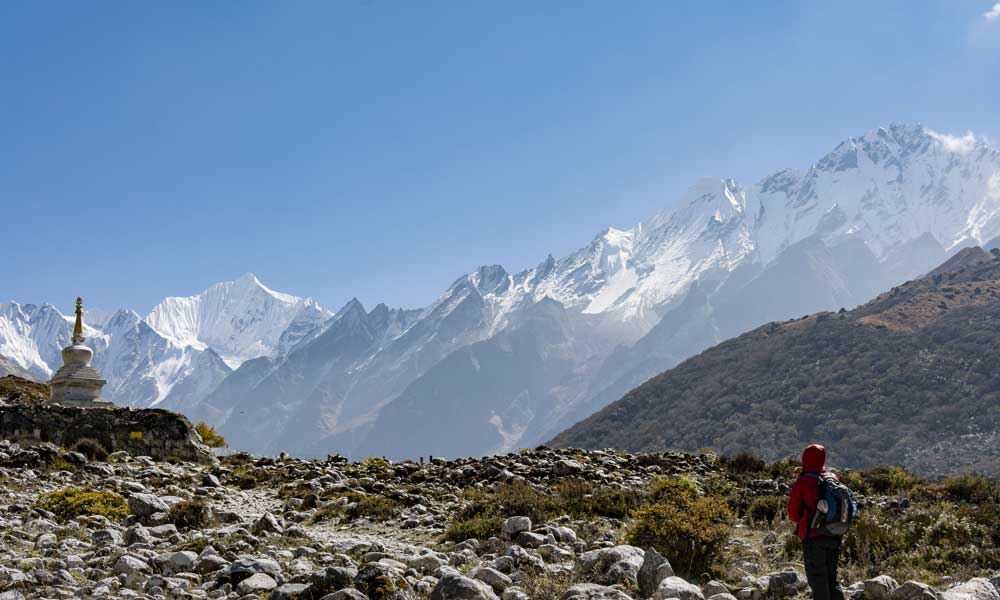 Detailed Itinerary
Detailed Itinerary
The Details in the Itinerary below give you more description on the 11 Days Langtang Valley Trek.
Day 1: Arrive at Tribhuvan International Airport
Our representatives responsible for pick up will be waiting for you prior to your arrival.
Then they will receive you and drop you off at your respective hotels. You must be tired from the long flight, so you can freshen up and rest in your rooms.
If you don’t feel like resting then you can roam around the hotel area.
Day 2: Explore Kathmandu Valley
Today you will explore the beautiful Kathmandu Valley. So wake up early, freshen up and get ready for your tour.
You will be visiting many places today among them some are the UNESCO Heritage Sites.
One of the sites is Pashupatinath which is holy ground for Hindu followers. The temple is usually crowded on Mondays.
From there Boudhanath stupa is about 1 and a half-hour drive. The stupa is holy grounds for Buddhists. You can see a few small monasteries inside the wall of Boudha.
Swayambhunath is also another Buddhist Stupa in this city. It is located on the top of the hill which is also known as Monkey Temple.
Basantapur Durbar Square is about a 1-hour drive from Swayambhu. The durbar square was once home for royal families. Now it is a local attraction site for tourists.
There are various other places to explore in this city such as Patan Durbar Square, Thamel and many more.
After a full day city tour, you must be exhausted so you will rest for the day.
Day 3: Drive to Syabru Besi
The third day of your trip is when the journey begins for this trek. You will wake up early and pack your things for this trip.
You drive all the way to Syabru Besi from Kathmandu which is about a 7-8 hours drive. Along the way, you will view villages and small settlements until you reach Trishuli bazar.
From the bazaar, you head towards Dhunche which is about a 2 hours drive. Then from there, you will reach Syabru Besi.
The roads are uneven which can make the ride a little uncomfortable. But the mesmerizing view of mountain peaks and green hills will make up for it.
The wonderful village of Syabru Besi is at an elevation of 1467 m. You will spend your night in one of the tea houses.
Day 4: Trek from Syabru Besi to Lama Hotel
This is the fourth day of your trek, you will be heading towards Lama Hotel from Syabru Besi. Today you will be walking about 5-6 hours covering a distance of 11.3 km.
You begin your trek walking above the Trishuli river then crossing the suspension bridge you climb gently till Bamboo. Bamboo is at an altitude of 1960 m.
After that, you start climbing steeply inside the forest paths until you reach Rimche which is at an altitude of 2400 m.
From there you walk straight in the trails viewing the mesmerizing mountains such as Ganesh Himal, Manaslu, and many more.
If luck is in your favor you might even sight wildlife such as Red Panda, Himalayan black bear, etc.
Then sightseeing you reach Lama Hotel which is situated at an altitude of 2470 m.
After a few hours walk, you will call it a day and rest there.
Day 5: Trek from Lama Hotel to Langtang Village
Today you will be heading towards Langtang village from Lama Hotel. It takes about a 6-7 hours walk covering a distance of 14.8 km.
Today you will make many ascents on these routes. Walking through the dense forests you see Rhododendron with different shades of color. You also get to see different trees of pine, oak, etc.
After climbing for some time, you will reach Ghora Tabela which is at an altitude of 3000m. From here you again walk inside the forests, you can witness many Langur monkeys on the tree branches.
Listening to the chattering sound made by the monkeys you head out the forest. Crossing small streams you reach Langtang village headquarter of Langtang National park.
Langtang village is at an elevation of 3430 m. The small village is very ravishing surrounded by mountain ranges and unique landscapes.
Today you will call it a night in this beautiful village.
Day 6: Trek from Langtang Village to Kyangjin Gompa
Your sixth day is a short trek, you will head towards Kyangjin Gompa from Langtang Village. It is about a 3-4 hours walk covering a distance of 6.8 km.
As you ascend these trails you walk past many small villages and grounds where yak graze during day time. Walking further ahead it opens up a wider view of the landscapes.
This day you will be crossing a lot of streams before reaching Kyangjin Gompa. Along the way, you get to see many mountains such as Langtang Lirung. Ganesh Himal, etc.
Kyangjin Gompa is at an altitude of 3810 m. Today you will have walked only a few hours. It gives you enough time to tour the village and also lets your body adjust at this altitude.
You can also visit the famous cheese factory in this region. You can enjoy the rich culture this village has to offer for you.
You will stay here tonight.
Day 7: Hike to Tsergo Ri and Explore the Valley
Today you wake up with the beautiful view of mountains surrounding you. This day is important for you as you will hike till Tsergo Ri.
Tsergo Ri is situated at an altitude of 4990 m which is the highest point of this trek. The remarkable view you get of the villages below will mesmerize you from there.
You also get to view the stunning mountain peaks of Langtang Lirung, Mt. Annapurna II, etc.
After a short hike, you return back to Kyangjin Gomba which is named after a religious community in Buddhism. The village is home to the Tamang community.
You can visit the religious community of the village. The village has pictures and statues of Buddha carved in woods and stones.
You sometimes get to witness the cultural and traditional dance too. The warm hospitality they offer makes you feel welcomed.
After a memorable day in the valley, you will stay here tonight.
Day 8: Trek back to Lama Hotel
After an unforgettable day, you retrace your steps and head back to Lama hotel. You will be walking for about 6-7 hours covering a distance of 21.6 km this day.
While returning through the same trails you can rest in Ghoda Tabela for some time. The paths are downhills making the walk a lot faster compared to climbing uphill.
You will descend more than 1430 m and reach Lama Hotel.
You will rest here tonight.
Day 9: Trek from Lama Hotel to Syabru Besi
On your ninth day, you will be traveling from Lama Hotel to Syabru Besi. The starting point of your trek is the ending point of this trek. You will be walking for about 5-6 hours today.
As you trek down you walk past the colorful forests of rhododendron filled with different species of trees.
You reach Syabru Besi and stay here tonight.
Day 10: Drive back to Kathmandu
Today you wake up and drive back to Kathmandu. While returning you will be viewing the mountains for the last time before you enter the busy city.
You will be dropped off at your hotel. This is your last day in Nepal so you can freshen up and roam around Thamel. It is the most happening place in the capital.
Or you can rest and call it a night.
Day 11: Departure
Today you will pack your things and check out your hotel. After you have finished getting ready you will be dropped off at the airport. You will leave this country with wonderful memories.
Index Adventure wishes you a safe journey. We hope your time here was as you had expected it to be. Visit us again!
If you seek travel information or more details on tours and packages, feel free to write to us.
Few related articles you may like:
 Major Highlights of Langtang Valley Trek 11 Days
Major Highlights of Langtang Valley Trek 11 Days Before going on the 11 days Langtang Valley Trek you should know a few things in advance. Here are some tips for this trek:
Before going on the 11 days Langtang Valley Trek you should know a few things in advance. Here are some tips for this trek: Detailed Itinerary
Detailed Itinerary